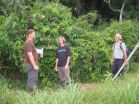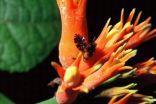(Press-News.org) RIVERSIDE, Calif. — Auxin, a small molecule, is a plant hormone discovered by Charles Darwin about 100 years ago. Over the years that followed it became understood to be the most important and versatile plant hormone controlling nearly all aspects of plant growth and development, such as bending of shoots toward the source of light (as discovered by Darwin), formation of new leaves, flowers, and roots, growth of roots, and gravity-oriented growth. Just how a small molecule like auxin could play such a pivotal role in plants baffled plant biologists for decades.
Then, about ten years ago, an auxin sensing and signaling system was discovered in the cell's nucleus, but it could not explain all the diverse roles of auxin.
Now, plant cell biologists at the University of California, Riverside have discovered a new auxin sensing and signaling complex, one that is localized on the cell surface rather than in the cell's nucleus. The discovery provides new insights into the mode of auxin action, the researchers say.
"This is a new milestone in auxin biology and will ignite interest in the field," said Zhenbiao Yang, a professor of cell biology in the Department of Botany and Plant Sciences, and the leader of the research project. "Our findings conclusively demonstrate the existence of an extracellular auxin sensing system in plants, which had long been proposed but remained elusive. Further, we have uncovered the decades-long mystery of how ABP1, an auxin-binding protein, works to control plant developmental processes."
ABP1 was identified more than 40 years ago, but its role was hotly debated among plant biologists because its mode of action remained unclear — until the recent discovery by Yang's team.
The team also showed that the cell surface auxin sensing system involves "transmembrane receptor kinases" (TMKs) — enzymes widespread throughout eukaryotes that typically act as cell surface sensors for extracellular stimuli and translate them into intracellular responses.
"This breakthrough discovery of the cell surface ABP1/TMK auxin sensing system dramatically elevates the level of our understanding of how auxin plays diverse roles," said Natasha Raikhel, a distinguished professor of plant cell biology at UC Riverside, who was not involved in the research. "This signaling mechanism now serves as a paradigm for elucidating the molecular mechanisms underlying various auxin-modulated developmental processes and patterns. In addition to their major impact on the field of plant development and morphogenesis and plant signal transduction, Yang's discoveries also provide novel means of engineering plants with desired morphological traits and growth patterns."
Study results appear in the Feb. 28 issue of Science.
Yang's lab has been studying molecular mechanisms for the formation of the jigsaw puzzle-piece shape of pavement cells in leaf epidermis of the Arabidopsis plant, a small flowering plant widely used in plant biology laboratories as a model organism. It is the interlocking feature of these cells that provides the required physical strength and integrity for flat, thin leaves.
In previous work, the lab found that auxin activated the formation of the puzzle piece shape through ABP1 and ABP1-dependent activation of "ROP GTPases," which are pivotal regulatory proteins that act as a molecular switch in gating incoming signals from the cell surface. It was unclear, however, whether ABP1 was a cell surface auxin receptor. Also, just how it led to the activation of ROP GTPases remained unknown.
"But now we have identified a family of TMKs that physically and functionally interact with ABP1 to perceive and transduce auxin signal at the cell surface," Yang said. "We show that ABP1 and TMKs form a new auxin sensing complex at the cell surface and that TMKs transmit extracellular auxin signals to ROP GTPases located just inside of the cell membrane. This novel auxin sensing and signaling system makes possible the formation of the jigsaw shape of leaf epidermal cells and many other auxin-mediated processes."
Next, Yang's team plans to investigate whether there are additional components in the cell surface auxin sensing complex, what specific pathways are regulated by the cell surface auxin sensor, and why plants need both the nuclear and extracellular auxin sensors.
INFORMATION:
Yang was joined in the study by researchers at UCR; the National University of Singapore; the Chinese Academy of Sciences; the University of Wisconsin; Ghent University, Belgium; the Institute of Science and Technology, Austria; the University of North Carolina, Chapel Hill; and Masaryk University, the Czech Republic.
The research was supported by a grant to Yang from the National Institute of General Medical Sciences.
The University of California, Riverside is a doctoral research university, a living laboratory for groundbreaking exploration of issues critical to Inland Southern California, the state and communities around the world. Reflecting California's diverse culture, UCR's enrollment has exceeded 21,000 students. The campus opened a medical school in 2013 and has reached the heart of the Coachella Valley by way of the UCR Palm Desert Center. The campus has an annual statewide economic impact of more than $1 billion. A broadcast studio with fiber cable to the AT&T Hollywood hub is available for live or taped interviews. UCR also has ISDN for radio interviews. To learn more, call (951) UCR-NEWS.
Plant biology discovery furthers scientists' understanding of plant growth and development
UC Riverside scientists discover auxin sensing and signaling complex on plant cell surface that explains why leaf epidermal cells have jigsaw puzzle-piece shapes
2014-03-13
ELSE PRESS RELEASES FROM THIS DATE:
Mid-level solar flare seen by NASA's SDO
2014-03-13
The sun emitted a mid-level solar flare, peaking at 6:34 p.m. EDT on March 12, 2014, and NASA's Solar Dynamics Observatory, or SDO, captured an image of it. Solar flares are powerful bursts of radiation. Harmful radiation from a flare cannot pass through Earth's atmosphere to physically affect humans on the ground, however -- when intense enough -- they can disturb the atmosphere in the layer where GPS and communications signals travel.
To see how this event may impact Earth, please visit NOAA's Space Weather Prediction Center at http://spaceweather.gov, the U.S. government's ...
Halting immune response could save brain cells after stroke
2014-03-13
MADISON — A new study in animals shows that using a compound to block the body's immune response greatly reduces disability after a stroke.
The study by scientists from the University of Wisconsin School of Medicine and Public Health also showed that particular immune cells – CD4+ T-cells produce a mediator, called interleukin (IL) -21 that can cause further damage in stroke tissue. Moreover, normal mice, ordinarily killed or disabled by an ischemic stroke, were given a shot of a compound that blocks the action of IL-21. Brain scans and brain sections showed that the ...
Condon publishes new research in Science
2014-03-13
A wasp's sting might explain it all.
Marty Condon, professor of biology at Cornell College, has been studying flies in the tropics for years, and in a paper published in Science this week, she reports evidence that there is more to a fly's ecological niche than where it lives and what it eats—you have to look at what eats the fly, as well.
In a previous Science paper, Condon and her co-researchers found that there were far more species of flies feeding on tropical flowers than expected. It was counter-intuitive, Condon said, to see so many species of flies filling what ...
Scripps Florida scientists devise new, lower cost method to create more usable fuels
2014-03-13
JUPITER, FL – March 13, 2014 – As the United States continues to lead the world in the production of natural gas, scientists from the Florida campus of The Scripps Research Institute (TSRI) have devised a new and more efficient method with the potential to convert the major components found in natural gas into useable fuels and chemicals—opening the door to cheaper, more abundant energy and materials with much lower emissions.
The research, which was led by TSRI Professor Roy Periana, uses clever chemistry and nontraditional materials to turn natural gas into liquid ...
Scripps Research Institute scientists discover a better way to make unnatural amino acids
2014-03-13
LA JOLLA, CA—March 13, 2014—Chemists at The Scripps Research Institute (TSRI) have devised a greatly improved technique for making amino acids not found in nature. These "unnatural" amino acids traditionally have been very difficult to synthesize, but are sought after by the pharmaceutical industry for their potential medical uses.
"This new technique offers a very quick way to prepare unnatural amino acids, many of which are drug candidates or building blocks for peptide drugs," said Jin-Quan Yu, a professor in TSRI's Department of Chemistry.
Yu's team has reported ...
Scientists find new way to upgrade natural gas
2014-03-13
America's current energy boom may take a new direction thanks to the discovery of a new way to turn raw natural gas into upgraded liquid alcohol fuel.
In the March 14 issue of Science magazine, chemists from Brigham Young University and The Scripps Research Institute detail a process that could reduce dependence on petroleum.
The most unexpected breakthrough in the paper was that ordinary "main group" metals like thallium and lead can trigger the conversion of natural gas to liquid alcohol. The research teams saw in experiments that natural gas to alcohol conversion ...
Stumbling fruit flies lead scientists to discover gene essential to sensing joint position
2014-03-13
LA JOLLA, CA—March 13, 2014—Scientists at The Scripps Research Institute (TSRI) have discovered an important mechanism underlying sensory feedback that guides balance and limb movements.
The finding, which the TSRI team uncovered in fruit flies, centers on a gene and a type of nerve cell required for detection of leg-joint angles. "These cells resemble human nerve cells that innervate joints," said team leader Professor Boaz Cook, who is an assistant professor at TSRI, "and they encode joint-angle information in the same way."
If the findings can be fully replicated ...
A novel battleground for plant-pathogen interactions
2014-03-13
Scientists at The Sainsbury Laboratory in Norwich, with collaborators at Michigan State University and the University of Illinois, have unveiled a new way in which plants perceive pathogens to activate immunity.
They also show how pathogens inhibit the mechanism to cause disease. It was previously only associated with other processes in mammalian cells.
When plants detect microbial molecules, they trigger immune responses to prevent disease. Although several plant immune receptors for these microbial molecules are known, how they are activated once the microbe is recognised ...
When big isn't better: How the flu bug bit Google
2014-03-13
Numbers and data can be critical tools in bringing complex issues into crisp focus. The understanding of diseases, for example, benefits from algorithms that help monitor their spread. But without context, a number may just be a number, or worse, misleading.
"The Parable of Google Flu: Traps in Big Data Analysis" is published in the journal Science, funded, in part, by a grant from the National Science Foundation. Specifically, the authors examine Google's data-aggregating tool Google Flu Trend (GFT), which was designed to provide real-time monitoring of flu cases around ...
More to biological diversity than meets the eye
2014-03-13
Most of us already imagine the tropics as a place of diversity—a lush region of the globe teeming with a wide variety of exotic plants and animals. But for researchers Andrew Forbes and Marty Condon, there's even more diversity than meets the eye.
In a paper published in the March 14 issue of the journal Science, Forbes and Condon report the discovery of extraordinary diversity and specialization in the tropics.
The paper builds upon previous research conducted by Condon, who discovered surprising diversity while researching plant species in South America. Later, she, ...
LAST 30 PRESS RELEASES:
Penn researchers awarded $25M to conduct trial using smartphones to fight heart disease
PCORI awards funding for new patient-centered healthcare research
Exploring the origins of the universe: 145 low-noise amplifiers complete ALMA telescopes
Empress cicada wings help illuminate molecular structure
Using sound waves to detect helium
Time burden in patients with metastatic breast and ovarian cancer from clinic and home demands
Researchers discover bias in AI models that analyze pathology samples
Scientists ID potential way to prevent brain injuries from triggering Alzheimer's
MASTER 2nd Open Call: Execution period kick-off
Algae for health in food and pharma
Advanced microrobots driven by acoustic and magnetic fields for biomedical applications
Chicago health information leader recognized for raising CPR readiness and blood pressure awareness
The Intimate Animal, a new book from Kinsey Institute Executive Director Dr. Justin Garcia
When blue-collar workers lose union protection, they try self-employment
New video dataset to advance AI for health care
MEA-based graph deviation network for early autism syndrome signatures in human forebrain organoids
New modeling approach sheds light on rare gut disease
Study documents potentially hazardous flame retardants in firefighter gear
Can certain bacteria regulate aging of the immune system and its related alterations?
AI model helps diagnose often undetected heart disease from simple EKG
There are fewer online trolls than people think
Cell membrane fluctuations produce electricity
Jeonbuk National University study shows positive parenting can protect adolescents against self-harm
Surface-engineered ZnO nanocrystals to tackle perfluoroalkyl substance contamination
This new understanding of T cell receptors may improve cancer immunotherapies
A new fossil face sheds light on early migrations of ancient human ancestor
A new immunotherapy approach could work for many types of cancer
A new way to diagnose deadly lung infections and save lives
40 percent of MRI signals do not correspond to actual brain activity
How brain-inspired algorithms could drive down AI energy costs
[Press-News.org] Plant biology discovery furthers scientists' understanding of plant growth and developmentUC Riverside scientists discover auxin sensing and signaling complex on plant cell surface that explains why leaf epidermal cells have jigsaw puzzle-piece shapes








